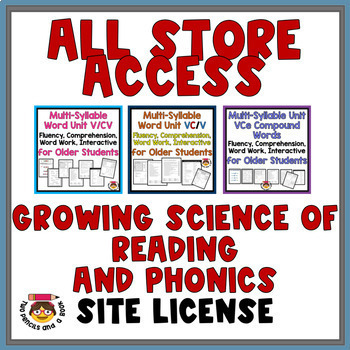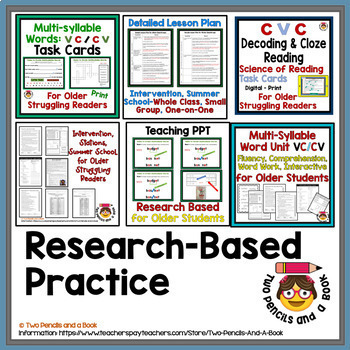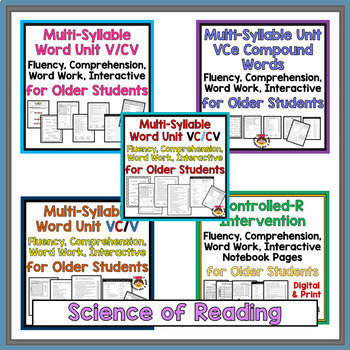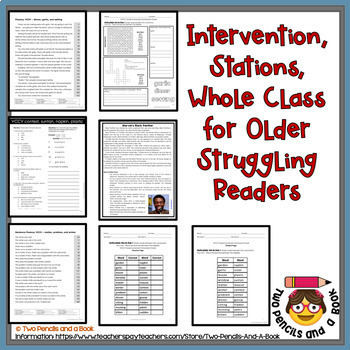Science of Reading Phonics ALL STORE ACCESS - Growing Bundle Older Students
- Zip
- Google Apps™
- Easel Activity

Products in this Bundle (48)
showing 1-5 of 48 products
Description
GIANT Growing Bundle of every Science of Reading Phonics resource I add to my store. This phonics work includes reading comprehension, fluency, word attack, syllabication and more - all embedded into research-based phonics programs.
*********ENTIRE STORE ACCESS BUNDLE**********
Full and complete Store Access to all the Science of Reading Phonics Resources in my TPT store is available with the purchase of this Science of Reading Phonics Resources Access License. Single classroom use only.
With this license, you will have GROWING, FULL and IMMEDIATE access to all of the specific phonics and science of reading resources in my TPT store – with guaranteed monthly additions.
When more resources are added, the price will increase, but you will never have to pay more once you purchase this bundle. These resources are constantly being updated so check back frequently for downloads.
This includes all print, Google Slide and Easel Resources.
This bundle contains fluency, comprehension, word work, teaching PowerPoints, interactive workbook pages, assessments, task cards and more. This program is research-based - with the research is included.
This program works for resource, whole class, RTI, summer school, and more. If you are using this program with more than one student – partner up. Partnering students is engaging and lets everyone participate.
This program helps students build confidence while reinforcing learning; additionally, by reading, tracking and reading again, student exposure to each passage is maximized.
Multisyllabic Word Reading Research
To progress in reading, students must have strategies for decoding big words. From fifth grade on, the average student encounters about 10,000 new words each year. Most of these words are multisyllabic. (Nagy and Anderson 1984).
It is helpful for students to be familiar with the common rules for syllable division. Knowing these rules and being able to apply them flexibly will help students decode longer multisyllabic words. (Carreker 2005; Henry 2010b)
According to Shefelbine and Calhoun 1991, “Low decoders, correctly pronounced fewer affixes and vowel sounds, disregarded large portions of letter information and were two to four times more likely to omit syllables.”
Several studies have shown that teaching students strategies for decoding longer words improves their decoding ability. (Archer et al. 2006; Archer 2018.)
Recognizing a Decoding Problem Symptoms:
- Guesses at words from context
- Avoids sounding out new words
- Confuses similar sounds, symbols, and/or words
- Inaccurate reading of nonsense words or words out of context
- Inadequate sight word vocabulary
- Tires easily, looks away, is easily frustrated, hates to read
These strategies build word recognition and build strong readers:
- Phonemic Awareness
- Vocabulary/Morphology
- Fluency
Teaching Syllabication
- Syllabication instruction teaches a struggling reader strategies to decode multi-syllable words quickly.
- Students learn to systematically break a multisyllable work into small manageable syllables, identify the vowel sounds within each syllable and “sound out” the word syllable by syllable.
- As students progress through the lessons, they will internalize the process and apply it easily and effortlessly.
- They will become faster, more efficient and fluent readers who comprehend at a higher level.
Fluency Research
To be considered “on level” in reading fluency, students should be able to read aloud an unrehearsed passage, (i.e., either narrative or expository, fiction or non-fiction that is 200 to 300 words in length) from a grade-level text, with at least 95% accuracy in word reading. As students read aloud, their reading should sound as effortless as if they were speaking (Hasbrouck & Glaser, 2012.) This does not come easily for some students, which is why fluency practice is so essential.
In order to be considered fluent readers, students in grades 9 through 12 should be able to correctly read 150 words per minute (Hasbrouck & Tindal, 2006). In 2006 and again in 2010, Hasbrouck and Hasbrouck and Tindal (respectively) put forth that “[i]t is sufficient for students to read unpracticed, grade-level text at the 50th percentile of oral reading fluency norms” and that “…teachers do not need to have students read faster because there is no evidence that reading faster than the 50th percentile increases comprehension.” See chart below.
The best strategy for developing and improving reading fluency is to provide students with many opportunities to read the same passages orally several times. These exercises provide such opportunities. On each passage, there is space for reading fluency calculations. The best part is that the passages are quick and make it easy for students to read aloud repeatedly – and often – without taking up a lot of valuable classroom time. The activities can also be spread over several days.
Blends now included.
Intervention: Multi-Syllable Word Unit for Older Students VC/CV - Fluency Plus
Multi-Syllable Word TASK CARDS for Older Students VC/CV
Intervention: Multi-Syllable Word Unit for Older Students V/CV - Fluency Plus
Multi-Syllable Word TASK CARDS for Older Students V/CV
Multi-Syllable Word TASK CARDS for Older Students VC/V
Intervention: Multi-Syllable Word Unit for Older Students VC/V - Fluency Plus





